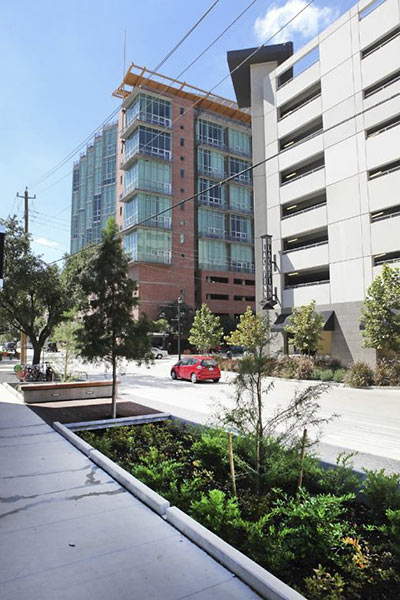
There are almost 6,000 miles of street in Houston, according to the Memorial Examiner, and now about a half a mile of one in Midtown can call itself remarkable. The Greenroads Foundation, which confers on streets a kind of LEED-like designation, gave its first formal props to a project in Texas to Bagby St. between Tuam and St. Joseph Pkwy., for the $9 million in improvements built along the 0.62-mile span the past few months.
Included in those improvements are bike racks, street furniture, wayfinding signs, wider sidewalks, and narrower, less harrowing crosswalks. (You can see in the photo above that these improvements don’t include burying utilities.) But the designation isn’t meant just to make the lives of pedestrians more aesthetically pleasing: LED lights were installed; rain gardens were put in to help with drainage; “fly ash” concrete, which reduces carbon emissions, was used where possible; and Bagby itself, with its potholes, patches, and cracks, was repaved atop what the Midtown Redevelopment Authority calls “newly stabilized materials” that are supposed to require less maintenance over the long haul.
Here are a few more looks at the transformation:
***
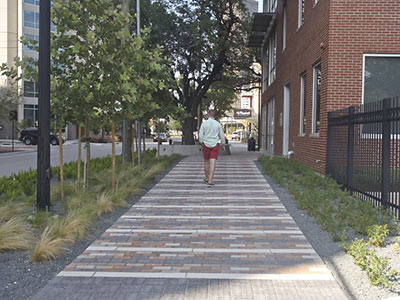
See how friendly to a pedestrian it is?
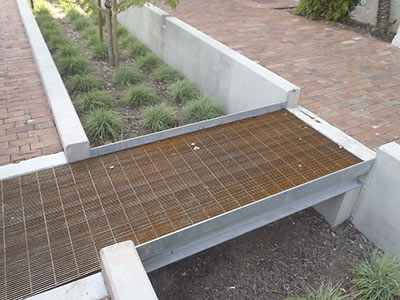
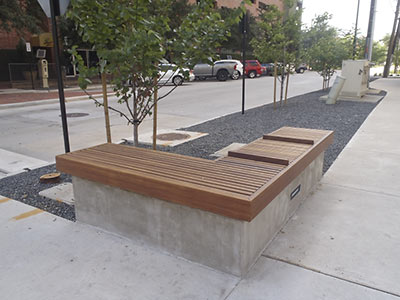
- Bagby Street Reconstruction [Greenroads]
- Midtown Redevelopment Authority Announces Silver Certification for First Greenroads Project in the State of Texas [Houston Midtown]
- Midtown street a sign of things to come [Memorial Examiner]
Photos: Memorial Examiner (first); Walter P. Moore (all others)



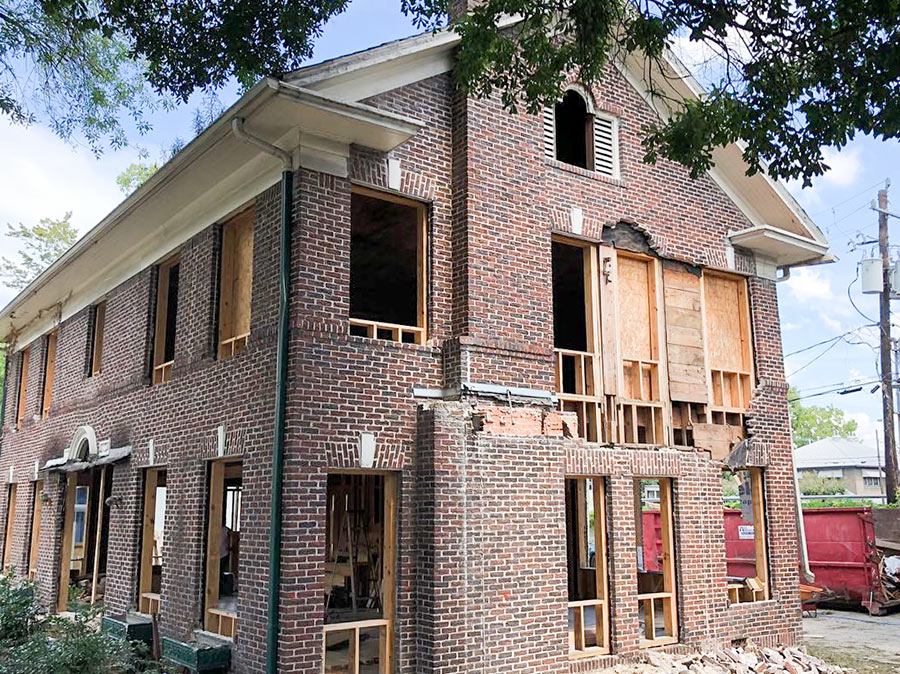
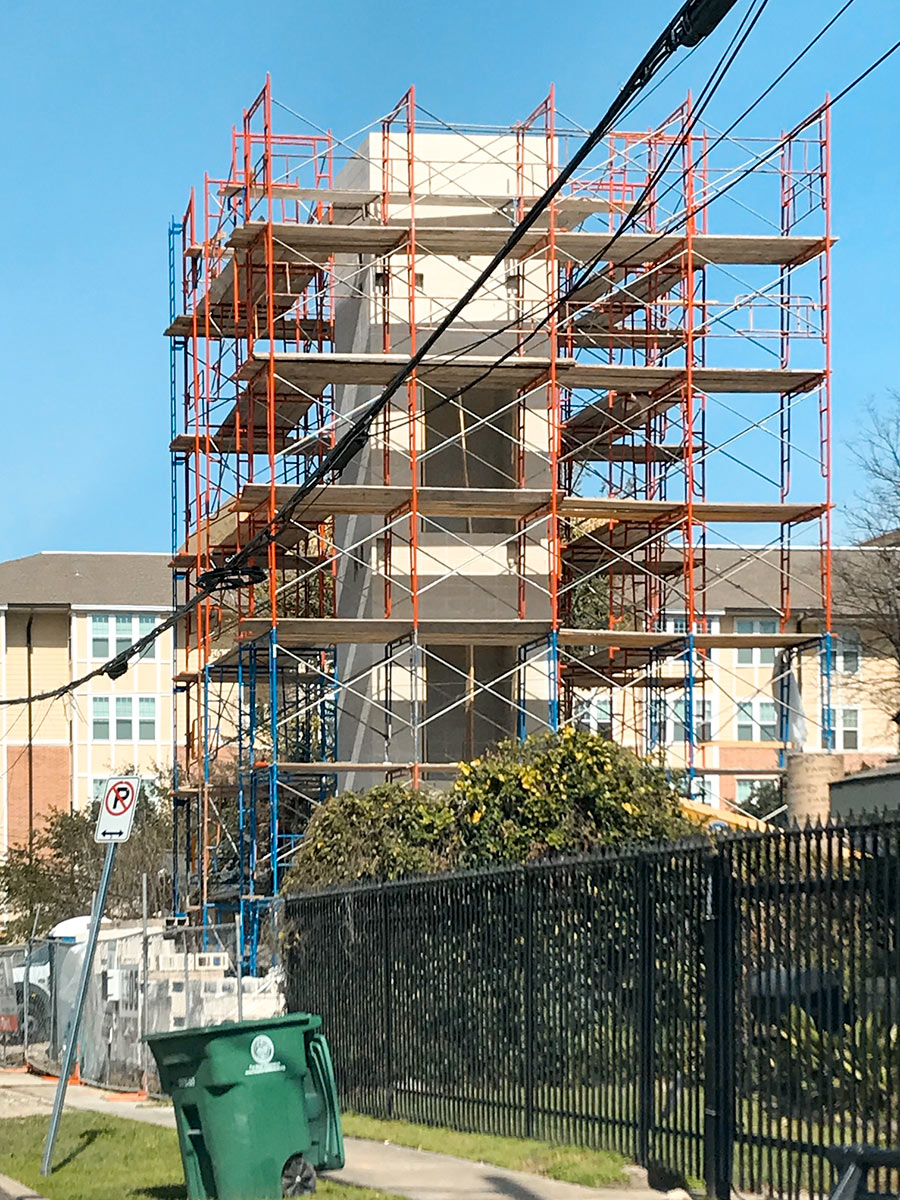
Great streetscape improvements! I do hope everything follows through and this becomes the new standard for Houston’s streets!
As for burying utilities as pointed out in the article, I could care less as long as they are not obstructing the pedestrian realm. I feel like they add to the urban environment and provide the potential for community postings and create a sense of a street wall. In some instances burying utilities works, but do we really want to be like suburbia and bury all utilities?
My boyfriend lives along this stretch of Bagby, and we’re wondering how long until we find a wayward Midtown party girl trapped along with the rainwater. Talk about making a splash in the party scene!
Good start–unfortunately, when walking at the corner Dunlavy and Westheimer, for example, Bagby Street feels thousands of miles away.
Great improvements. I think that is because they are in different neighborhoods.
$9million? Hope it was mostly TIRZ funds. That amount of money could repave many blocks of asphalt streets in various neighborhoods.
It’s too bad every Houston neighborhood doesn’t have enough shady lawyers and politicians on the payroll to create a TIRZ.
Midtown property owners pay the same tax rates as everyone else, yet a huge slice of their tax dollars are looted from the general fund and allocated for specific “public” improvements to the neighborhood.
We need so much more of this!
this city needs to repave Richmond from 610 to Montrose!!! Quit blowing money in downtown/midtown!!
Drive down it every day to get on the spur and it looks great. Hate the way the lanes are around West Gray and Webster are though-so curvy and not enough attentive drivers.
This is beautiful and a great example of what is possible on the very high end of such projects. But the price tag is shocking to say the least, so I want to throw out an example of what can be done for 2% of the cost ($280k/mile, rather than$14.5 million/mile):
http://gridchicago.com/2011/recap-on-the-kinzie-street-protected-bike-lane/
Certainly not as pretty, but it gets people using the street, which justifies further beautification later and incentivizes private entities to foot the bill. Without more humble but widespread street improvements, the Bagby project is just anothe pretty island to drive to.
This improvement was crucial and it serves as a demonstration of what can be done in the rest of the city. It is a proof of concept in my view. All houstonians should push for this type of standard to be applied on their streetscape.
$9mil is high but it includes a lot of special features like the fly ash concrete and rain gardens. Simply adding wider sidewalks and bike lanes will go a long way to matching Bagby’s walkability, but at a much lower price.
Another thing to consider: the more people walk and bike, the less beating our concrete will take. A larger up-front investment in complete streets will pay off in less road maintenance down the line.
midtown has lots of density; the city is right to invest heavily in the area. Do more.
It is definitely an improvement, but sheesh, over-designed much?
Even 26 years ago, when we moved close to there, it was kind of cool.
Looks nice, but the $9 million figure is high. I hope that includes some money for maintaining all of the nice work that they’ve done.
Now, can we get back to fixing some roads, which gives us a bigger bang for the buck?
$9 MILLION. The Mayor/Midtown TIRZ/et al sure are generous with OTHER People’s Money!!!And the “improvements” REDUCED the street from FOUR lanes to TWO. That must be fricking wonderful at rush hour. Forget “improving” it using this model and KEEP the FOUR lanes.@ Bernard: Exactly. @ Raison: I’m waiting for a news story one evening: cell phone using driver runs into the “rain gardens”. That’ll be hilarious.And yes some of the partiers of Midtown WILL fall into the “rain gardens” ! That will be priceless.
Maybe it is expensive, but perhaps it’ll pay off in the long run. From what I’ve read, the concrete used is meant to last longer and not break as easily and it also appears to be an investment on drainage that doubles as green space and shade for pedestrians. Not to mention that it’ll probably help promote even more businesses around there and residential.
It looks beautiful but I wonder if the idea of rain gardens in between streets and sidewalks will cause, here in Houston anyway, a moisture differential which would cause excessive cracking of the concrete on either side/more maintenance.
I agree with eiioi on the maintenance issue. So often, entities like TxDot or COH install some nice landscaping that immediately starts going downhill due to neglect. If we’re going to continue in that pattern, it would be better if we designed these improvements to be low-maintenance. In that regard, the earlier comment about over-designing things is very apropos.
Looks like we need to raise 108 Billion to finish the rest of the city. That works out to around $51,438.00 per person at 2.1 million people in the city. As many suggest perhaps we could cut the original 9 million down a lot. Maybe the 6000 miles includes major highways? We could spread this out over 20 years..? How much would taxes really need to go up? Could we have a 1-2% sales tax increase in the COH and pay for these kind of things?
“Another thing to consider: the more people walk and bike, the less beating our concrete will take.” Can you really type that with a straight face? How much longer will the streets last if 2% fewer people drive?
Yet more hipster ideas without thinking about cost or long term burden. We’ll all forget about this nonsense very soon.
The cost should come right down once some serious economies of scale get going. This place has a lot of mass produced things, why not mass produce this?
I haven’t seen it in person but the pics look great, although the festive sidewalk I can personally do without.
This update is great and all, but it would be nice if the city would try repairing the potholes and bumps along almost every major street in Houston first (or at least concurrently). How many streets could have been repaved for that amount?
Richmond is a disaster from the Beltway to Downtown. It’s like playing a video game to avoid all the things that damage your tires and shocks.
I don’t put much faith in a plan to make major upgrades to our streets and sidewalks when minimum maintenance can’t even be handled.
Hmm, maybe the West End and the Heights could be re-envisioned with rain gardens instead of open drainage ditches.
That is what I am thinking – rain gardens instead of drainage ditches. There must be federal money out there (eventually, not now haha) to be used for something like this.
Or maybe make it part of the setbacks-and-variances package around LRT development. Point is, there should be more of this, I think.
Limestone’s comment beat me to it, was thinking the same thing about gussying up the Heights, Rice Military, Aldine, etc.
The use of pavers on those sidewalks probably tripled the cost per square foot. Pretty, yes, but economically unfeasible.
So much jealousy here. You know you could move here too if you wanted to enjoy the sidewalks. What is the common saying on swamplot… “If you dont like it you can move”, same applies when something is nicer than your neighborhood. Oh, whats that? you can’t afford to move here because it is too expensive and the taxes are higher than your shitty neighborhood with open drainage ditches? Maybe these residents do pay more in taxes and deserve the $9 million to fix their roads and sidewalk. There are a lot more people per acre living here and paying a lot more taxes than in your 2 acres per house country road that has potholes where you can lose a truck. If anything, all you people living out in the middle of nowhere in Pearlland and other far out places are draining our tax dollars so you can have water and sewer pipes that extend for hundreds and hundreds of feet for just one house. Who is costing the taxpayers more money?
I am intrigued to see a bayou converted to a rain garden, now that I know what a rain garden is. (Would that make it a flood garden?)
I believe there was a project in South Korea that did something similar with a creek in one of the big cities.
FWIW, Bagby used to look like it was used for artillery practice too.
Much of the damage on arterials is by very heavy vehicles (*cough**busses**cough*)…wasn’t there something way back when about Metro giving some of its sales tax revenue to the city to take care of the damage the busses do to the streets in exchange for not building a monorail, or rail, or anything other than more busses? Wasn’t that the idea of a developer mayor?
Suwoop
What they are calling ‘raingardens’ is just an extreme micro-version of a detention basin. Filled with shrubs and trees it is designing to detain the stormwater. This serves to slow the rate of flow before it hits the storm sewer. The water is releases at a slower rate so it’s not hitting our drainage ways during the peak flow. It the other benefit to slowing the flow is that sediments/pollutants can settle out before they go into our streams and bayous.
I love the project but I do have some complaints. There are parts of the project that just don’t seem sustainable and smart going forward. Many of the landscaping is covered in some sort of black rock. It seems like it will only get kicked around torn up, etc and have to be replaced. More maintenance. Where there are plants and green there are sprinkler systems to keep them watered. Sprinkler systems seem like a waste in public spaces. Way too much maintenance. Why not sustainable ground covers/grasses that require less maintenance?
Ok, I finally got a chance to check this out today (before it rained, so who knows if the “rain gardens” really work), and I think it was worth every penny considering:
(1) Bagby itself was repaved (according to the article in a way that requires less maintenance which I guess means more upfront cost), and
(2) a significant chunk of the cost probably went into the original designs, which now that they exist, can be replicated for free from here on out.
It felt designed, almost like being somewhere else, and Bagby being finally improved was a nice touch. Maybe extend it all the way to 59 so it’s not such a letdown once you get to Tuam.
Anyway I would like to see more of this – a lot more. The designs have already been paid for, so might as well implement them wherever and whenever.